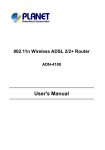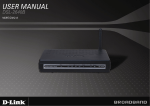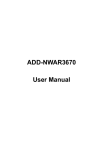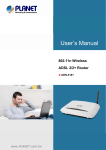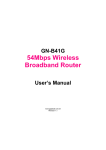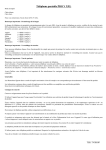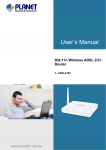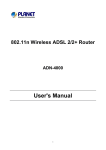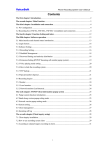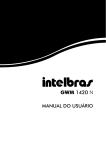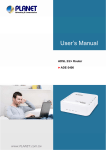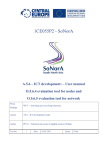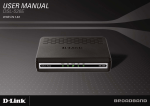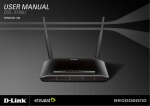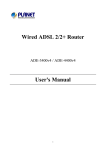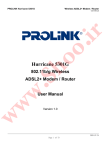Download User Manual ADN-4100v3
Transcript
802.11n Wireless ADSL 2/2+ Router ADN-4100 Copyright Copyright© 2012 by PLANET Technology Corp. All rights reserved. No part of this publication may be reproduced, transmitted, transcribed, stored in a retrieval system, or translated into any language or computer language, in any form or by any means, electronic, mechanical, magnetic, optical, chemical, manual or otherwise, without the prior written permission of PLANET. PLANET makes no representations or warranties, either expressed or implied, with respect to the contents hereof and specifically disclaims any warranties, merchantability or fitness for any particular purpose. this manual is sold or licensed "as is". Any software described in Should the programs prove defective following their purchase, the buyer (and not this company, its distributor, or its dealer) assumes the entire cost of all necessary servicing, repair, and any incidental or consequential damages resulting from any defect in the software. Further, this company reserves the right to revise this publication and to make changes from time to time in the contents hereof without obligation to notify any person of such revision or changes. All brand and product names mentioned in this manual are trademarks and/or registered trademarks of their respective holders. Federal Communication Commission Interference Statement This equipment has been tested and found to comply with the limits for a Class B digital device, pursuant to Part 15 of FCC Rules. These limits are designed to provide reasonable protection against harmful interference in a residential installation. This equipment generates, uses, and can radiate radio frequency energy and, if not installed and used in accordance with the instructions, may cause harmful interference to radio communications. However, there is no guarantee that interference will not occur in a particular installation. If this equipment does cause harmful interference to radio or television reception, which can be determined by turning the equipment off and on, the user is encouraged to try to correct the interference by one or more of the following measures: 1. Reorient or relocate the receiving antenna. 2. Increase the separation between the equipment and receiver. 3. Connect the equipment into an outlet on a circuit different from that to which the receiver is connected. 4. Consult the dealer or an experienced radio technician for help. FCC Caution To assure continued compliance (example-use only shielded interface cables when connecting to computer or peripheral devices). Any changes or modifications not expressly approved by the party responsible for compliance could void the user’s authority to operate the equipment. This device complies with Part 15 of the FCC Rules. Operation is subject to the Following two conditions: (1) This device may not cause harmful interference, and (2) this Device must accept any interference received, including interference that may cause undesired operation. Federal Communication Commission (FCC) Radiation Exposure Statement This equipment complies with FCC radiation exposure set forth for an uncontrolled environment. In order to avoid the possibility of exceeding the FCC radio frequency exposure limits, human proximity to the antenna shall not be less than 20 cm (8 inches) during normal operation. R&TTE Compliance Statement This equipment complies with all the requirements of DIRECTIVE 1999/5/EC OF THE EUROPEAN PARLIAMENT AND THE COUNCIL OF 9 March 1999 on radio equipment and telecommunication terminal Equipment and the mutual recognition of their conformity (R&TTE) The R&TTE Directive repeals and replaces in the directive 98/13/EEC (Telecommunications Terminal Equipment and Satellite Earth Station Equipment) As of April 8, 2000. ii WEEE Regulation To avoid the potential effects on the environment and human health as a result of the presence of hazardous substances in electrical and electronic equipment, end users of electrical and electronic equipment should understand the meaning of the crossed-out wheeled bin symbol. Do not dispose of WEEE as unsorted municipal waste and have to collect such WEEE separately. Safety This equipment is designed with the utmost care for the safety of those who install and use it. However, special attention must be paid to the dangers of electric shock and static electricity when working with electrical equipment. All guidelines of this and of the computer manufacture must therefore be allowed at all times to ensure the safe use of the equipment. Energy Saving Note of the Device This power required device does not support Standby mode operation. For energy saving, please remove the power cable or push the power button to OFF position to disconnect the device from the power circuit. Without removing power cable or Power off, the device will still consuming power from the power source. In the view of Saving the Energy and reduce the unnecessary power consuming, it is strongly suggested to remove the power connection for the device if this device is not intended to be active. Revision User’s Manual for 802.11n Wireless ADSL 2/2+ Router Model: ADN-4100 Rev: 1.0 (March. 2012) Part No. EM-ADN4100v3_v1.0 iii National restrictions This device is intended for home and office use in all EU countries (and other countries following the EU directive 1999/5/EC) without any limitation except for the countries mentioned below: Country Bulgaria Restriction Reason/remark Generalaauthorization required for outdoor use None and public service. Military Radiolocation use. Refarming of the 2.4 GHz France Outdoor use limited to 10 mW e.i.r.p. within the band 2454-2483.5 MHz band has been ongoing in recent years to allow current relaxed regulation. Full implementation planned 2012. If used outside of own premises, general Italy None authorization is required. iv General authorization required for network Luxembourg None and service supply (not for spectrum) This subsection does not apply for the geographical Norway Implemented area within a radius of 20 km from the centre of Ny-Ålesund. Only for indoor applications Russian Federation None v i CONTENT 1 U Overview ........................................................................................... 1 U U 1.1 U 1.2 U 1.3 U 1.4 U 2 U 3 U U Safety Precautions ................................................................... 2 U U U U U U U U U LEDs and Interfaces ................................................................ 2 U System Requirements .............................................................. 4 U Features .................................................................................... 5 U Hardware Installation ..................................................................... 9 U U U U U Web Configuration ........................................................................ 11 3.1 U 3.2 U U Accessing the Device .............................................................. 11 U U U U U General Configuration .......................................................... 12 U 3.2.1 Wizard ................................................................................... 12 U U U U 3.2.2 Internet Setup ....................................................................... 19 U U U U 3.2.3 Wireless Setup ...................................................................... 21 U U U 3.2.3.1 U 3.2.3.2 U U Wireless Basics ........................................................... 22 U U U U U Wireless Security ........................................................ 23 U 3.2.4 Local Network ...................................................................... 30 U U U U 3.2.5 LAN IPv6 .............................................................................. 34 U U U U 3.2.6 Time and Date ....................................................................... 35 U U U U 3.2.7 Logout ................................................................................... 36 U 3.3 U U U U U Advanced Configuration ....................................................... 37 U U 3.3.1 Advanced Settings ................................................................ 37 U U U U ii 3.3.1.1 U 3.3.1.2 U 3.3.1.3 U 3.3.1.4 U MAC Filtering ............................................................ 40 U U U U U U U U U Security Settings ......................................................... 41 U WPS Settings .............................................................. 42 U WDS Settings .............................................................. 43 U 3.3.2 Port Forwarding ................................................................... 44 U U U U 3.3.3 DMZ ...................................................................................... 47 U U U U 3.3.4 Parental Control ................................................................... 47 U U U U 3.3.4.1 U 3.3.4.2 U Block Website ............................................................. 48 U U U U U MAC Filter ................................................................. 49 U 3.3.5 Filtering Options .................................................................. 51 U U U U 3.3.5.1 U 3.3.5.2 U IP Filtering .................................................................. 52 U U U U U Bridge Filtering .......................................................... 54 U 3.3.6 QoS Configuration ............................................................... 55 U U U U 3.3.6.1 U 3.3.6.2 U 3.3.6.3 U QoS Global Option .................................................... 56 U U U U U U U Queue Configuration ................................................. 56 U Classification Configuration ..................................... 57 U 3.3.7 Firewall Settings ................................................................... 59 U U U U 3.3.8 DNS ........................................................................................ 59 U U U U 3.3.9 Dynamic DNS ....................................................................... 61 U U U U 3.3.10 Network Tools ..................................................................... 62 U U U U 3.3.10.1 Port Mapping. ............................................................ 64 U U U U 3.3.10.2 IGMP Proxy ............................................................... 65 U U U U 3.3.10.3 IGMP Snooping .......................................................... 66 U U U U 3.3.10.4 UPnP ........................................................................... 66 U U U U iii 3.3.10.5 ADSL Settings ............................................................ 67 U U U U 3.3.10.6 SNMP .......................................................................... 68 U U U U 3.3.10.7 TR-064 ........................................................................ 69 U U U U 3.3.10.8 TR-069 ........................................................................ 69 U U U U 3.3.10.9 Certificates ................................................................. 71 U U U U 3.3.10.10 PPTP ........................................................................... 72 U U U U 3.3.10.11 IPSec ........................................................................... 74 U U U U 3.3.11 Routing ................................................................................ 78 U U U U 3.3.11.1 Static Route ................................................................ 79 U U U U 3.3.11.2 Policy Route ................................................................ 80 U U U U 3.3.11.3 Default Gateway. ........................................................ 81 U 3.3.11.4 U U U U U U RIP Settings ............................................................... 81 U 3.3.12 Schedules ............................................................................. 82 U U U U 3.3.13 NAT ...................................................................................... 83 U U U U 3.3.14 Logout ................................................................................. 84 U 3.4 U U U U Management ........................................................................... 85 U U U 3.4.1 System ................................................................................... 85 U U U U 3.4.2 Firmware Update ................................................................. 86 U U U U 3.4.3 Access Controls ..................................................................... 87 U U U 3.4.3.1 U 3.4.3.2 U 3.4.3.3 U U Account Password ...................................................... 88 U U U U U U U Services ....................................................................... 89 U IP Address ................................................................... 90 U 3.4.4 Diagnostics ............................................................................ 91 U U U 3.4.4.1 U U U WAN Diagnostics ....................................................... 91 U U iv 3.4.4.2 U Ping Diagnostics ......................................................... 92 U U U 3.4.5 Log Configuration ................................................................ 93 U U U U 3.4.6 Logout ................................................................................... 94 U 3.5 U U U U U Status ...................................................................................... 95 U U 3.5.1 Device Information ............................................................... 95 U U U U 3.5.2 Wireless Clients .................................................................... 96 U U U U 3.5.3 DHCP Clients ........................................................................ 96 U U U U 3.5.4 IPv6 STATUS ........................................................................ 97 U U U U 3.5.5 Logs ....................................................................................... 98 U U U U 3.5.6 Statistics ................................................................................. 98 U U U U 3.5.7 Route information .............................................................. 100 U U U U 3.5.8 Logout ................................................................................. 100 U 3.6 U U U U U Help ....................................................................................... 101 U U Appendix A : Specification .............................................................. 102 U U v 1 Overview 0B High-Speed 802.11n Wireless Data Rate The PLANET 802.11n Wireless ADSL 2/2+ Router with 2T2R MIMO antenna technology, ADN-4100A, provides office and residential users the ideal solution for sharing a high-speed ADSL 2/2+ broadband Internet connection and four-10/100Mbps Fast Ethernet backbone. It can support downstream transmission rates of up to 24Mbps and upstream transmission rates of up to 3.5Mbps. The product supports PPPoA (RFC 2364 - PPP over ATM Adaptation Layer 5), RFC 2684 encapsulation over ATM (bridged or routed), PPP over Ethernet (RFC 2516), and IPoA (RFC1483) to establish a connection with ISP. Wireless Coverage Plus ! With built-in IEEE 802.11b/g/n wireless network capability, all computers and wireless-enabled network devices can connect to ADN-4100A without additional cabling. The ADN-4100A is equipped with external 5dBi hi-gain antenna which provides stronger signal strength and excellent performance, you can transfer file up to 300Mbps (transfer data rate) upload and download data rate, so you don’t need to worry if the size of your office or house is big. Advanced Wireless Security To secure the wireless communication, ADN-4100A supports most up-to-date encryption, WEP, and WPA-PSK/ WPA2-PSK. In order to simplify the security settings, ADN-4100A supports WPS configuration with PBC/PIN type. Your whole wireless network can be secured. Advanced Networking function for Specific Application Via the user-friendly management interface, ADN-4100A can be managed by workstations running standard web browsers. Furthermore, ADN-4100A provides DHCP server, NAT, Virtual Server, DMZ, Access Control, IP Filter, PPTP / IPSec 1 VPN, DDNS, and UPnP capability. For further IP compatibility it supports IPv6 as well. 1.1 Safety Precautions 3B Refer to the following instructions to prevent the device from risks and damage caused by fire or electric power: Use volume labels to mark the type of power. Use the power adapter packed within the device package. Pay attention to the power load of the outlet or prolonged lines. An overburden power outlet or damaged lines and plugs may cause electric shock or fire accident. Check the power cords regularly. If you find any damage, replace the power cords at once. Proper space left for heat dissipation is necessary to avoid damage caused by overheating to the device. The long and thin holes on the device are designed for heat dissipation to ensure that the device works normally. Do not cover these heat dissipation holes. Do not put this device close to a place where a heat source exits or high temperature occurs. Avoid the device from direct sunshine. Do not put this device close to a place where it is over damp or watery. Do not spill any fluid on this device. Do not connect this device to any PCs or electronic products, unless our customer engineer or your broadband provider instructs you to do this, because any wrong connection may cause power or fire risk. Do not place the device on an unstable surface or support. 1.2 LEDs and Interfaces 4B Front Panel 2 The following table describes the LEDs of the device. LED Color Green PWR Status On Off Red On Slow Blinks Link Green Description The device is powered on and the initialization is normal. The power is off. The device is self-testing or self-testing is failed. No signal is detected. Fast The device is handshaking with the physical Blinks layer of the office. On The device is connected to the physical layer of the office. The Internet connection is normal in the On successful), and no Internet data is being transmitted. Green Data routing mode (for example: PPP dial-up is Blinks Off Internet data is being transmitted in the routing mode. The device is in the bridge mode. The Red On Internet connection fails after successful synchronization in the routing mode (for example: PPP dial-up is failed). On The LAN connection is normal. Data is being transmitted through the LAN LAN4-1 Green Blinks interface, or the Internet data is being transmitted in the bridge mode. Off On WLAN Green Blinks Off WPS Green Blinks Off The LAN connection is not established. The WLAN connection has been activated. Data is being transmitted through the WLAN interface. The WLAN connection is not activated. WPS is activated and the device is waiting for negotiation with the clients. WPS is not activated. 3 Rear Panel The following table describes the interfaces and buttons of the device. Interface/Button LINE Description RJ-11 interface, for connecting the interface of the telephone set through the telephone cable. LAN1,LAN2, RJ-45 interface, for connecting the Ethernet interface of a LAN3,LAN4 computer or an Ethernet device. POWER Power interface, for connecting the interface of the power adapter. Restore to factory defaults. To restore factory defaults, RESET keep the device powered on, push a paper clip into the hole to press the button for over 3 seconds and then release. Press the button and hold it for 1 second, to enable/disable WLAN. WPS/ WLAN Press the button and hold it for 3 or more than 3 seconds, to initialize WPS negotiation. ON/OFF 1.3 Power switch, power on or off the device. System Requirements 5B Recommended system requirements are as follows: A 10Base-T/100Base-TX Ethernet card is installed on your PC. A hub or switch is available for connecting one Ethernet interface on the device and several PCs. Operating system: Windows 7 \ Vista \ XP \ 2008 server \ 2003 server \ 2000 \ ME \ 98SE. 4 Internet Explorer V6.0 or higher, Netscape V4.0 or higher, or Firefox 1.5 or higher 1.4 Features 6B The device supports the following features: Internet Access Features Shared Internet Access All users on the LAN can access the Internet through ADN-4100A using only a single external IP Address. The local (invalid) IP Addresses are hidden from external sources. This process is called NAT (Network Address Translation). Built-in ADSL 2/2+ Modem ADN-4100A provides ADSL 2/2+ modem, and supports all common ADSL connections. PPPoE, PPPoA, and Direct Connection Support Various WAN connections are supported by ADN-4100A. Multiple PVCs for Triple-Play Service(Data, IPTV, VoIP application) Co work with data, IPTV and IP telephony services protocol through specific PVCs at the same time. Fixed or Dynamic IP Address On the Internet (WAN port) connection, ADN-4100A supports both Dynamic IP Address (IP Address is allocated on connection) and Fixed IP Address. Advanced Internet Functions QoS (Quality of Service) divides this capacity between the different applications and provides underplayed, continuous data transfer where data packets with higher priority are given preference. 5 Firewall Supports simple firewall with NAT technology and provides option for access control from Internet, like Telnet, FTP, TFTP, HTTP, SNMP, and ICMP services. It also supports IP/MAC /Application/URL filtering. Port Forwarding (Virtual Server) This feature allows Internet users to access Internet servers on your LAN. The required setup is quick and easy. DMZ Support ADN-4100A can translate public IP addresses to private IP address to allow unrestricted 2-way communication with Servers or individual users on the Internet. This provides the most flexibility to run programs, which could be incompatible in NAT environment. Parental Control and Scheduling ADN-4100A provides parents to help protect their children and set restrictions while surfing Internet. Universal Plug and Play (UPnP) UPnP allows automatic discovery and configuration of the Broadband Router. UPnP is supported by Windows ME, XP, or later. Dynamic DNS Support When used with the Virtual Servers feature, ADN-4100A allows users to connect to Servers on your LAN using a Domain Name, even if you have a dynamic IP address which changes every time you connect. VPN Pass through Support PCs with VPN (Virtual Private Networking) software using PPTP, L2TP, and IPSec are transparently supported - no configuration is required. PPTP and IPSec VPN ADN-4100A supports PPTP and IPSec VPN tunneling, The IPSec VPN has DES, 3DES and AES encryption and SHA-1/MD5 authentication. 6 RIP Routing ADN-4100A supports RIPv1/2 routing protocol for routing capability. Simple Network Management Protocol (SNMP) It is an easy way to remotely manage the router via SNMP. LAN Features 4-Port Switch ADN-4100A incorporates a 4-Port 10/100BaseT switching hub, making it easy to create or extend your LAN. DHCP Server Support Dynamic Host Configuration Protocol provides a dynamic IP address to PCs and other devices upon request. ADN-4100A can act as a DHCP Server for devices on your local LAN and WLAN. IPv6 ADN-4100A implements the new IP version for further compatibility of network environment. Wireless Features Standards Compliant ADN-4100A complies with IEEE 802.11n radio with wireless technology capable of up to 300Mbps data rate. Dipole Antenna with MIMO Technology ADN-4100A provides farther coverage, less dead spaces and higher throughput with 2T2R MIMO technology. Support IEEE 802.11b, g and 802.11n Wireless Station The 802.11n standard provides for backward compatibility with the 802.11b and 802.11g standard, so 802.11b, 802.11g, and 802.11n can be used simultaneously. WEP Support WEP (Wired Equivalent Privacy) is included. Key sizes of 64 Bit 7 and 128 Bit are supported. WPS Push Button Control ADN-4100A supports WPS (Wi-Fi Protected Setup) to easy connect wireless network without configuring the security. WPA-PSK Support WPA-PSK_TKIP and WPA2-PSK_AES encryption are supported. Wireless MAC Access Control The Wireless Access Control feature can check the MAC address (hardware address) of Wireless stations to ensure that only trusted Wireless Stations can access your LAN. WDS ADN-4100A supports wireless distribution system; it allows the wireless interconnection of access point in an IEEE 802.11 network. 8 2 Hardware Installation 1B Step 1 Connect the LINE interface of the device and the Modem interface of the splitter with a telephone cable. Connect the phone set to the Phone interface of the splitter through a telephone cable. Connect the input cable to the Line interface of the splitter. The splitter has three interfaces: Line: Connect to a wall phone interface (RJ-11 jack). Modem: Connect to the LINE interface of the device. Phone: Connect to a telephone set. Step 2 Connect the LAN interface of the device to the network card of the PC through an Ethernet cable (MDI/MDIX). Note: Use the twisted-pair cable to connect the hub or switch. Step 3 Insert one end of the power adapter to the wall outlet and connect the other end to the POWER interface of the device. Connection 1: Figure 1 shows the connection of the device, PC, splitter, and X X telephone set, when no telephone set is placed before the splitter. This type of connection is recommended. Figure 1 Connection diagram (without a telephone set before the splitter) 9 Connection 2: Figure 2 shows the connection of the device, PC, splitter, and X X telephone set, when a telephone set is placed before the splitter. As illustrated in the following figure, the splitter is installed close to the device: Figure 2 Connection diagram (with a telephone set before the splitter) Note: When connection 2 is used, the filter must be installed close to the telephone cable. See Figure 2 . Do not use a splitter to replace the filter. X X Installing a telephone directly before the splitter may lead to failure of connection between the device and the central office, failure of Internet access, or slow connection speed. If you need to add a telephone set before the splitter, you must add a microfilter before the telephone set. Do not connect several telephones before the splitter or connect several telephones with the microfilter. 10 3 Web Configuration 2B This chapter describes how to configure the device by using the Web-based configuration utility. 3.1 Accessing the Device 7B The following describes how to access the device for the first time in detail. Step 1 Open the Internet Explorer (IE) browser and enter http://192.168.1.1 HU UH in the address bar. Step 2 The LOGIN page as shown in the following figure appears: In this page, enter the user name and the password. Then, click login. The user name and the password of the super user are admin and admin respectively. The user name and the password of the normal user are user and user respectively. If the login information is incorrect, the page as shown in the following figure appears: 11 Click OK to log in again. Note: In the LAN, you can use either of the following two levels of user accounts (displayed in the user name/password format) to access the device: admin/admin and user/user. In the WAN, you can use one of the following three levels of user accounts (displayed in the user name/password format) to access the device: admin/admin, user/user, and support/support. 3.2 General Configuration 8B 3.2.1 Wizard 14B Wizard helps you to fast and accurately configure Internet connection and other important parameters. The following sections describe these various configuration parameters. When subscribing to a broadband service, be aware of the Internect connection mode. The physical WAN device can be Ethernet, DSL, or both. Technical information about properties of Internet connection is provided by your Internet service provider (ISP). For example, your ISP should inform you whether you are connected to the Internet using a static or dynamic IP address, and the protocol, such as PPPoA or PPPoE, that you use to communicate on the Internet. 12 Step 1 Choose Setup > Wizard. The page as shown in the following figure appears: Step 2 Click Setup Wizard. The page as shown in the following figure appears: There are four steps to configure the device. Click Next to continue. 13 Step 3 Set the time and date. Then, click Next. Step 4 Configure the Internet connection. Select the protocol and the encapsulation mode. Set the VPI and the VCI. If the Protocol is set to PPPoE or PPPoA, the page as shown in the following figure appears: 14 You need to enter the user name and password for PPPoE or PPPoA dialup. If the Protocol is set to Dynamic IP, the page as shown in the following figure appears: If the Protocol is set to Static IP, the page as shown in the following figure appears: 15 You need to enter the information of the IP address, subnet mask, and gateway. If the Protocol is set to Bridge, the page as shown in the following figure appears: After setting, click Next. 16 Step 5 Configure the wireless network. Enter the information and click Next. 17 Step 6 View the configuration information of the device. To modify the information, click Back. To effect the configuration, click Next. Note: In each step of the Wizard page, you can click Back to review or modify the previous settings or click Cancel to exit the wizard. 18 3.2.2 Internet Setup 15B Choose Setup > Internet Setup. The page as shown in the following figure appears: In this page, you can configure the WAN interface of the device. Click Add and the page as shown in the following figure appears: The following table describes the parameters in this page. 19 Field Description ATM PVC CONFIGURATION Virtual Path Identifier (VPI) is the virtual path between two VPI points in an ATM network. Its value range is from 0 to 255. Virtual Channel Identifier (VCI) is the virtual channel between two points in an ATM network. Its value range is VCI from 32 to 65535 (0 to 31 is reserved for local management of ATM traffic). Service Category Peak Cell Rate Select UBR with PCR, UBR without PCR, CBR, Non Realtime VBR, or Realtime VBR from the drop-down list. Set the maximum transmission rate of the cell in ATM transmission. Sustainable Cell Set the minimum transmission rate of the cell in ATM Rate transmission. Maximum Burst Size Set the maximum burst size of the cell in ATM transmission. CONNECTION TYPE Select PPP over ATM (PPPoA), PPP over Ethernet Protocol (PPPoE), MAC Encryption Routing (MER), IP over ATM (IPoA), Bridging or PPTP from the drop-down list. Encapsulation Select LLC or VCMUX from the drop-down list. Usually, Mode you can select LLC. If you enter a value, packets from the interface is tagged 802.1Q VLAN ID with the set 802.1q VLAN ID. Its value range is 0-4094, while 0 indicates to disable this function. Enable Proxy Arp Check this to enable proxy arp. Protocol Type You can select the IPv4,IPv6 or IPv4&6 NETWORK ADDRESS TRANSLATION SETTINGS Select or deselect the check box to enable or disable the Enable NAT NAT connection. Select Symmetric Nat or Full cone Nat from the NAT Type Enable Service drop-down list WAN Select or deselect the check box to enable or disable the WAN connection. 20 Field Description The name to identify the WAN connection. You need not Service Name 3.2.3 modify it. Wireless Setup 16B This section describes the wireless LAN and some basic configuration. Wireless LANs can be as simple as two computers with wireless LAN cards communicating in a pear-to-pear network or as complex as a number of computers with wireless LAN cards communicating through access points that bridge network traffic to a wired LAN. Choose Setup > Wireless. The WIRELESS SETTINGS page as shown in the following figure appears: 21 3.2.3.1 Wireless Basics 49B In the WIRELESS SETTINGS page, click Wireless Basic. The page as shown in the following figure appears: In this page, you can configure the parameters of wireless LAN clients that may connect to the device. The following table describes the parameters in this page. Field Enable Wireless Enable MultiAP Isolation Description Select or deselect the check box to enable or disable the wireless function. Select or deselect the check box to enable or disable multiAP isolation. If this function is enabled, clients of different SSIDs cannot access each other. Wireless Network Network name. It can contain up to 32 characters. It Name (SSID) can consist of letters, numerals, and/or underlines. Visible indicates that the device broadcasts the Visibility Status SSID. Invisible indicates that the device does not broadcast the SSID. 22 Field Description Channel Standard Control Sideband You can select from the drop-down list: FCC(1-11), ETS(1-13), JP(1-14) You can select Upper or Lower from the list Select the wireless channel used by the device from Wireless Channel the drop-down list. You can select Auto Scan or a value from CH1—CH13. Auto Scan is recommended. Select the 802.11 mode of the device from the 802.11 Mode drop-down list. The device supports 802.11b, 802.11g, 802.11n, 802.11b/g, 802.11n/g, and 802.11b/g/n. You can set the bandwidth only in the 802.11n mode. Band Width You can set the bandwidth of the device to 20M or 40M. Click Apply to save the settings. 3.2.3.2 Wireless Security 50B In the WIRELESS SETTINGS page, click Wireless Security. The page as shown in the following figure appears: Wireless security is vital to your network to protect the wireless communication among wireless stations, access points and the wired network. This device 23 provides the following encryption modes: None, WEP, Auto (WPA or WPA2), WPA2 Only, and WPA Only. WEP If the Security Mode is set to WEP, the page as shown in the following figure appears: . 24 The following table describes the parameters in this page. Field Description You can select 64 bits or 128 bits from the drop-down list. If you select 64 bits, you need to enter 10 WEP Key Length hexadecimal numbers or 5 characters. If you select 128 bits, you need to enter 26 hexadecimal numbers or 13 characters. Choose WEP Key WEP Keys 1—4 Authentication Select the WEP key from the drop-down list. Its value range is 1—4. Set the 64 bits or 128 bits key, in the format of Hex or ASCII. Select the authentication mode from the drop-down list. You can select Open or Share Key. Click Apply to save the settings. Auto (WPA or WPA2) If the Security Mode is set to Auto (WPA or WPA2), the page as shown in the following figure appears: 25 The following table describes the parameters in this page. Field WPA Mode WPA Encryption Group Key Update Interval Pre-Shared Key Description You can select Auto (WPA or WPA2)-PSK or Auto (WPA or WPA2)-Enterprise from the drop-down list. You can select AES or TKIP+AES from the drop-down list. Set the interval for updating the key. Set the pre-shared key to identify the workstation. If the WPA Mode is set to Auto (WPA or WPA2)-Enterprise, the page as shown in the following figure appears: 26 You need to enter the IP address, port, shared key of the RADIUS server. Click Apply to save the settings. WPA2 Only If the Security Mode is set to WPA2 only, the page as shown in the following figure appears: 27 Parameters in this page are similar to those in the page for Auto (WPA or WPA2).Click Apply to save the settings. WPA Only If the Security Mode is set to WPA only, the page as shown in the following figure appears: 28 Parameters in this page are similar to those in the page for Auto (WPA or WPA2). Click Apply to save the settings. 29 3.2.4 Local Network 17B You can configure the LAN IP address according to the actual application. The preset IP address is 192.168.1.1. You can use the default settings and DHCP service to manage the IP settings of the private network. The IP address of the device is the base address used for DHCP. To use the device for DHCP in your LAN, the IP address pool used for DHCP must be compatible with the IP address of the device. The IP address available in the DHCP IP address pool changes automatically if the IP address of the device changes. You can also enable the secondary LAN IP address. The primary and the secondary LAN IP addresses must be in different network segments. Choose Setup > Local Network. The Local Network page as shown in the following figure appears: By default, Enable DHCP Server is selected for the LAN interface of the device. DHCP service provides IP settings to workstations configured to automatically obtain IP settings that are connected to the device through the Ethernet port. When the device is used for DHCP, it becomes the default gateway for DHCP client connected to it. If you change the IP address of the device, you must also change the range of IP addresses in the pool used for DHCP on the LAN. The IP 30 address pool can contain up to 253 IP addresses. You can also make DHCP server just acting on the specific port, by default, those ports are selected. If your DHCP server doesn’t belong to the same segment with your pc, but you need to assign IP address from DHCP server, you must uncheck the Enable DHCP Server and selected the Enable DHCP Relay to set the DHCP Relay IP address. And you can also set the preferred and alternate DNS server. Click Apply to save the settings. 31 In the DHCP CLIENT CLASS LIST page, you can set an IP address range for some specification device. The page as shown in the following figure appears: The following table describes the parameters in this page. Field Description Client Class Name Enter the Client Class name Min IP Address The IP Address for minimum Max IP Address The IP Address for maximum DNS Address Enter the DNS Address with the client class In the LOCAL NETWORK page, you can assign LAN IP addresses for specific computers according to their MAC addresses. Click Add to add static DHCP reservation. The page as shown in the following figure appears: 32 The following table describes the parameters in this page. Field Enable Description Select the check box to reserve the IP address for the designated PC with the configured MAC address. Enter the computer name. It helps you to recognize the Computer Name PC with the MAC address. For example, Father’s IP Address Enter the IP address of the computer. MAC Address Enter the MAC address of the computer. Laptop. Click Apply to save the settings. After the DHCP reservation information is saved, the DHCP reservations list displays the information. If the DHCP reservations list is not empty, you can select one or more items and click Edit or Delete. The NUMBER OF DYNAMIC DHCP CLIENTS page displays the DHCP clients (PCs or Laptops) currently connected to the device and the detailed information of the connected computers. 33 3.2.5 LAN IPv6 18B In this page,you can configure the LAN IPv6. Choose Setup > LAN IPv6. The IPv6 LAN setting page as shown in the following figure appears: The following table describes the parameters in this page. Field Start Unique Local Prefix Unique Local GlobalID Auto get prefix from WAN Static Description Check this enable the The default is 11:22:33:44:55 Check this to enable the Auto get prefix from WAN. Check this to enable the static prefix set. Site Prefix Type the Prefix address on this item. Site Prefix Length Means the network ID length, the range is 16-64 bit. You can select the SLAAC and DHCPv6 mode,the describes as follow: LAN address config SLAAC: The PC will obtained the prefix but not mode obtained the DNS DHCPv6:The PC will obtained the prefix and DNS from DHCPv6 34 3.2.6 Time and Date 19B Choose Setup > Time and Date. The TIME AND DATE page as shown in the following figure appears: In the TIME AND DATE page, you can configure, update, and maintain the time of the internal system clock. You can set the time zone that you are in and the network time protocol (NTP) server. You can also set daylight saving time to automatically adjust the time when needed. Select Auto matically synchronize with Internet time servers. Select the appropriate time server and the time zone from the corresponding drop-down lists. Select Enable Daylight Saving if necessary. Enter the correct the start and end time of the daylight saving.Click Apply to save the settings. 35 3.2.7 Logout 20B Choose Setup > Logout. The page as shown in the following figure appears: Click Logout to log out of the configuration page. 36 3.3 Advanced Configuration 9B This section contains advanced features used for network management, security and administrative tools to manage the device. You can view the status and other information of the device, to examine the performance and troubleshoot. 3.3.1 Advanced Settings 21B In the ADVANCED WIRELESS page, click Advanced Settings. The page as shown in the following figure appears: The following table describes the parameters in this page. Field Description ADVANCED WIRELESS SETTINGS Transmission Rate Multicast Rate Select the transmission rate of the wireless network from the drop-down list. Select the multicast transmission rate of the wireless network from the drop-down list. You can select Lower 37 Field Description or Higher. Select the power for data transmission from the Transmit Power drop-down list. You can select 100%, 80%, 60%, 40%, or 20%. Beacon Period RTS Threshold By default, the wireless beacon frame sends the data once every 100ms. Its value range is 20—1024. The threshold of transmission request. Its value range is 0—2347 and the default value is 2346. Fragmentation Its value range is 256—2346 and the default value is Threshold 2345. Data beacon proportion (transmission quantity DTIM Interval indication). Its value range is 1—255 and the default value is 100. Preamble Type Select the preamble code from the drop-down list. You can select long or short. Field Enable Wireless SSID Description Select or deselect the check box to enable or disable the wireless function. Set the wireless network name, that is, SSID. SSID is used to distinguish different wireless networks. Select whether to hide the AP. You can select Visible Visibility Status or Invisible. If you select Invisible, the AP is hidden and the terminal cannot obtain the SSID through passive scanning. 38 Select whether users of the AP can communicate with User Isolation each other. You can select Off or On from the drop-down list. On indicates that computers connected to the device cannot communicate with each other. WMM Advertise Select whether to enable WMM. Set the maximum number of clients that can be Max Clients connected to the AP at the same time. Its value range is 1—32. 39 Field Description Enable Wireless Select or deselect the check box to enable or disable Guest Network the wireless interface. SSID Similar to the primary SSID, it identifies a wireless AP. These settings are applicable only for more technically advanced users who have sufficient knowledge about wireless LAN. Do not change these settings unless you know the effect of changes on the device. Click Apply to save the settings. 3.3.1.1 MAC Filtering 51B In the ADVANCED WIRELESS page, click MAC Filtering. The page as shown in the following figure appears: Click Add and the page as shown in the following figure appears: The following table describes the parameters in this page. 40 Field Description Enter the MAC address of another device that is MAC Address included in MAC filtering. Click Apply to save the settings. 3.3.1.2 Security Settings 52B In the ADVANCED WIRELESS page, click Security Settings. The page as shown in the following figure appears: Select the desired SSID from the drop-down list. Select the encryption type from the Security Mode drop-down list. You can select None, WEP, AUTO (WPA or WPA2), WPA Only, or WPA2 Only. For parameters of different encryption types, see section. 3.2.3.2 Wireless Security X Click Apply to save the settings. 41 X X 3.3.1.3 WPS Settings 53B In the ADVANCED WIRELESS page, click WPS Setting. The WIRELESS WPS page as shown in the following figure appears: Note: Ensure that the network card supports the WPS function. Field Description Enabled The WPS service is enabled by default. Select Mode Select Enrollee or Registrar from the drop-down list. Select Configured or Unconfigured from the Configuration State drop-down list.Configured Means the WPS featuere already standby. Otherwise the Unconfigured means not yet ready If you are using the PIN method, you need a Registrar, Input Station PIN either an access point or a wireless router, to initiate the registration between a new device and an active 42 Field Description access point or a wireless router. You can use one of the following there methods to use WPS authentication: Press the WPS button on the side panel for 3 seconds. In the WIRELESS WPS page, click PBC. It has the same function of the WPS button on the side panel. This is an optional method on wireless clients. Note: You need a Registrar when using the PBC method in a special case in which the PIN is all zeros. 3.3.1.4 WDS Settings 54B In the ADVANCED WIRELESS page, click WDS Settings. The WIRELESS WDS page as shown in the following figure appears: The Wireless repeater function can make the WLAN signal cover more area. Fill the blanks and then Apply. 43 3.3.2 Port Forwarding 22B This function is used to open ports in your device and re-direct data through these ports to a single PC in your network (WAN-to-LAN traffic). It allows remote users to access services in your LAN, such as FTP for file transfers or SMTP, and POP3 for e-mail. The device receives remote requests for these services at your public IP address. It uses the specified TCP or UDP protocol and port, and redirects these requests to the server on your LAN with the specified LAN IP address. Note that the specified private IP address must be within the available IP address range of the subnet where the device is in. Choose Advanced > Port Forwarding. The page as shown in the following figure appears: 44 Click Add to add a virtual server. See the following figure: Please refer the description as below: Field WAN Connection Select a Service Description Select the WAN connection which you want the remote side via this connection to access in. Select the default service for the port forwarding. If you can’t find the service in the default service Custome Server column, you can create a new service name by Schedule Choose the schedule which you want to open the port yourself. 45 Field Description forwarding feature. You also can click” View Available H Schedules ”to select the schedule. H Enter an IP address in the Server IP Address field, to Server IP Address appoint the corresponding PC to receive forwarded packets. External Port Start-End Protocol Enter the service (service/Internet application) port number from the Internet that will be re-directed to the above Server IP Address host in your LAN Select the port number protocol type (TCP, UDP). This is the port number (of the above Server IP Internal Port Address) that the External Port number will be changed Start-End to when the packet enters your LAN (to the LAN Server/Client IP) The Remote IP means only this IP address can be Remote Ip forward to the local side, if leave this item blank, then every remoter IP can be forwarding. Click Apply to save the settings. The page as shown in the following figure appears. A virtual server is added. 46 3.3.3 DMZ 23B Choose Advanced > DMZ. The page as shown in the following figure appears: In this page, you can enable a DMZ host. In this way, access from Internet to the WAN IP address of the device is forwarded to the DMZ host and network server of the internal LAN is protected. Click Apply to save the settings. 3.3.4 Parental Control 24B Choose Advanced > Parental Control. The PARENTAL CONTROL page as shown in the following figure appears: 47 This page provides two useful tools for restricting Internet access. Block Website allows you to quickly create a list of websites that you wish to prevent users from accessing. MAC Filter allows you to control Internet access by clients or PCs connected to the device. 3.3.4.1 Block Website 55B In the PARENTAL CONTROL page, click Block Website. The page as shown in the following figure appears: Click Add. The page as shown in the following page appears: Enter the website in the URL field. Select the time to block websites from the Schedule drop-down list, or select Manual Schedule and set the corresponding time and days. Click Apply to add the website to the BLOCK WEBSITE table. The page as shown in the following figure appears: 48 3.3.4.2 MAC Filter 56B In the PARENTAL CONTROL page, click MAC Filter. The page as shown in the following figure appears: Click Add. The page as shown in the following figure appears: 49 The following table describes the parameters in this page. Field User Name Description Enter the name that identifies your configuration. For example, kids. Current PC’s MAC Enter the MAC address of the computer that connects Address to the device. Other MAC Address Schedule Manual Schedule Enter the MAC address of another device that is included in MAC filtering. Select the time of MAC filter from the drop-down list. You can select always or never. If you select this check box, you need to manually set the time of MAC filtering. Enter the use name and MAC address. Select the corresponding time and days. Then, click Apply to add the MAC address to the BLOCK MAC ADDRESS table. The page as shown in the following figure appears: 50 3.3.5 Filtering Options 25B Choose Advanced > Filtering Options. The FILTERING OPTIONS page as shown in the following figure appears: 51 3.3.5.1 IP Filtering 57B In the Filtering Options page, click IP Filtering. The FIREWALL page as shown in the following figure appears: Click Add to add an IP filter. The page as shown in the following figure appears: 52 Field Name Description Enter the name that identifies your configuration. Interface Select LAN or the other connection from the drop-down list. Type Select the In, Out or Both from the drop-down list. Default action Select the Permit or Drop from the drop-down list. Default Chain Select the Local, Forward or Both from the drop-down list. After set the firewall info finish, click Add Rule to add an IP filter rule. The page as shown in the following figure appears: Check the Enabled and specify at least one of the following criteria: protocol, source/destination IP address, subnet mask, and source/destination port. Then, click Apply to save the settings. Note: The settings apply only when the firewall is enabled. 53 3.3.5.2 Bridge Filtering 58B In the FILTERING OPTIONS page, click Bridge Filtering. The page as shown in the following figure appears: This page is used to configure bridge parameters. In this page, you can modify the settings or view the information of the bridge and its attached ports. Click Add to add a bridge filter. The page as shown in the following figure appears: The following table describes the parameters in this page. Field Protocol Type Description Select the protocol type to be mapped from the 54 Field Description drop-down list. You can select PPPoE, IPv4, IPv6, AppleTalk, IPX, NetBEUI, or IGMP. Destination MAC Address Source MAC Enter the destination MAC address to be mapped. Enter the source MAC address to be mapped. Address Select the frame direction to be mapped from the Frame Direction drop-down list. The device supports frame direction from LAN to WAN and WAN to LAN. Select the time that you want to apply the rule from the Time schedule drop-down list. You can select Always or Never. Select the WAN interface to be mapped from the Wan interface drop-down list. Click Apply to save the settings. 3.3.6 QoS Configuration 26B Choose Advanced > QoS Configuration. The page as shown in the following figure appears: 55 3.3.6.1 QoS Global Option 59B In the QoS Configuration page, click QoS Global Option. The page as shown in the following figure appears: In this page, you can select or deselect the check box to enable or disable the Queuing Operation. 3.3.6.2 Queue Configuration 60B In the QoS Configuration page, click Qos Queue Configuration. The page as shown in the following figure appears: In this page, you can configure the upstream bandwidth and downstream bandwidth of each interface. The uplink rate and the downlink rate are limited according to the configured bandwidth. You also can set the priority of the queue. 56 The device supports the following four priority levels: 1,2,3,4. Click Submit to save the settings. 3.3.6.3 Classification Configuration 61B In the QoS Configuration page, click QoS Classification Configuration. Click Add and the page as shown in the following figure appears: The following table describes the parameters in this page. Field Classify Type Enable Description You can select Upstream Flow Classify or Downstream Flow Classify Select or deselect the check box to enable or disable 57 Field Description QoS classification. SPECIFY TRAFFIC CLASSIFICATION RULES Select the physical port of the packet from the Input Interface drop-down list. For example, ethernet1, ethernet2, Source MAC Address Enter the source MAC address of the packet. ethernet3, and ethernet4. Source MAC Mask Use mask 000000ffffff to mask the MAC address. 00 indicates not mapped and ff indicates mapped. Select the 802.1p priority of the packet from the 802.1P drop-down list. You can select Not match or a value in the range of 0—7. Note that this function is not supported at the moment. Source IPv4 Address Enter the Source IP address of the packet. Source subnet mask Enter the Source subnet mask of the packet. Destination IPv4 Address Destination subnet mask Ethernet Type DSCP check Enter the destination IP address of the packet. Enter the destination subnet mask of the packet. Select the layer 2 protocol type from the drop-down list. For example, IP protocol and IPX protocol. You can use this feature to differentiate the complex data type from the drop-down list. Protocol Type Select the protocol on this column. Source port range Enter the source port range of the packet. Destination port range Enter the destination port range of the packet. CLASSIFY MATCH RESULT Classify Queue Specify the queue to which the packet belongs. You can set the queue in the classification configuration. DSCP Mark Attach the DSCP mark to the mapped packet. Cos Mark Attach the 802.1p mark to the mapped packet. Click Submit Apply to save the settings. 58 3.3.7 Firewall Settings 27B A denial-of-service (DoS) attack is one of the most common network attacks and is characterized by an explicit attempt by attackers to prevent legitimate users of a service from using that service. It usually leads to overload of system server or core dump of the system. Choose Advanced > Firewall Settings. The page as shown in the following figure appears: Click Apply to save the settings. 3.3.8 DNS 28B Domain name system (DNS) is an Internet service that translates domain names into IP addresses. Because domain names are alphabetic, they are easier to remember. The Internet, however, is actually based on IP addresses. Each time you use a domain name, a DNS service must translate the name into the corresponding IP address. For example, the domain name www.example.com might be translated to 198.105.232.4. 59 The DNS system is, in fact, its own network. If one DNS server does not know how to translate a particular domain name, it asks another one, and so on, until the correct IP address is returned. Choose Advanced > DNS. The page as shown in the following figure appears: The following table describes the parameters in this page. Field Wan Connection Description Select the WAN interface of the DNS server to be connected from the drop-down list. If you select this radio button, the device Obtain DNS server automatically obtains IP address of the DNS server address automatically from the ISP. You need not manually enter the IP address of the server. Use the following DNS server addresses Preferred DNS server If you select this radio button, you need to manually enter the IP address of the server provided by the ISP. Enter the IP address of the primary DNS server. Enter the IP address of the secondary DNS server. If Alternate DNS server the primary DNS server fails to work, the device tries to connect the secondary DNS server. Click Apply to save the settings. 60 3.3.9 Dynamic DNS 29B The device supports dynamic domain name service (DDNS). The dynamic DNS service allows a dynamic public IP address to be associated with a static host name in any of the many domains, and allows access to a specified host from various locations on the Internet. Click a hyperlinked URL in the form of hostname.dyndns.org and allow remote access to a host. Many ISPs assign public IP addresses using DHCP, so locating a specific host on the LAN using the standard DNS is difficult. For example, if you are running a public web server or VPN server on your LAN, DDNS ensures that the host can be located from the Internet even if the public IP address changes. DDNS requires that an account be set up with one of the supported DDNS service providers (DyndDNS.org or Dlinkddns.com). Choose Advanced > Dynamic DNS. The page as shown in the following page appears: Click Add to add dynamic DNS. The page as shown in the following figure appears: 61 The following table describes the parameters in this page. Field DDNS provider Description Select the DDNS provider from the drop-down list. You can select Planet , DynDns.org, TZO, or GnuDIP. Enter the host name that you register with your DDNS Hostname provider. Select the interface that is used for DDNS service from Interface the drop-down list. The IP address of the interface corresponds to the host name. Username Enter the user name of your DDNS account. Password Enter the password of your DDNS account. Click Apply to save the settings. 3.3.10 Network Tools 30B Choose Advanced > Network Tools. The NETWORK TOOLS page as shown in the following figure appears: 62 This page contains the following function items: Port Mapping, IGMP Proxy, IGMP Snooping, UPnP, ADSL, SNMP, TR-069, Certificates, PPTP.and IPSec 63 3.3.10.1 Port Mapping. 62B In the NETWORK TOOLS page, click Port Mapping. The page as shown in the following figure appears: In this page, you can bind the WAN interface and the LAN interface to the same group. Click Add to add port mapping. The page as shown in the following figure appears: 64 To create a mapping group, do as follows: Step 1 Enter the group name. Step 2 Select interfaces from the Available Interfaces list and click the <arrow button to add them to the Grouped Interfaces list, in this way, you can create the required mapping of the ports. The group name must be unique. Step 3 Click Apply to save the settings. 3.3.10.2 IGMP Proxy 63B In the NETWORK TOOLS page, click IGMP Proxy. The page as shown in the following figure appears: IGMP proxy enables the device to issue IGMP host messages on behalf of hosts that the system discovered through standard IGMP interfaces. The device serves as a proxy for its hosts after you enable the function. 65 Select Enable IGMP Proxy and select the desired WAN and click Apply to save the settings. 3.3.10.3 IGMP Snooping 64B When IGMP snooping is enabled, only hosts that belong to the group receive the multicast packets. If a host is deleted from the group, the host cannot receive the multicast packets any more. In the NETWORK TOOLS page, click IGMP Snooping. The page as shown in the following figure appears: Click Apply to save the settings. 3.3.10.4 UPnP 65B In the NETWORK TOOLS page, click Upnp. The page as shown in the following figure appears: 66 In this page, you can enable universal plug and play (UPnP) and then the system serves as a daemon. UPnP is widely applied in audio and video software. It automatically searches devices in the network. If you are concerned about UPnP security, you can disable it. Select the WAN and LAN interfaces at which you want to enable UPnP and click Apply to save the settings. 3.3.10.5 66B ADSL Settings In the NETWORK TOOLS page, click ADSL. The page as shown in the following figure appears: In this page, you can select the ADSL modulation. Normally, you are recommended to keep the factory defaults. The device supports the following modulation types: G.Dmt, G.lite, T1.413, ADSL2, AnnexL, ADSL2+, and AnnexM. The device negotiates the modulation mode with the DSLAM. Click Apply to save the settings. 67 3.3.10.6 SNMP 67B In the NETWORK TOOLS page, click SNMP. The page as shown in the following figure appears: In this page, you can set the SNMP parameters. The following table describes the parameters in this page. Field Enable SNMP Agent Description Select or deselect the check box to enable or disable SNMP agent. Universal character to obtain the device information. It Read Community is similar to the password. The SNMP application entity can use it to directly obtain the device information. Universal character to modify the device configuration. Set Community It is similar to the password. The SNMP application entity can use it to directly modify the device configuration. Trap Manager IP Trap Community Trap Version Enter the address of the server that receives the trap message. The field that is included in the trap message sent by the device. Select the trap version from the drop-down list. You can select v1 or v2c. 68 Click Apply to save the settings. 3.3.10.7 TR-064 68B In the NETWORK TOOLS page, click enable item to enable the TR-064 .The page as shown in the following figure appears: 3.3.10.8 TR-069 69B In the NETWORK TOOLS page, click TR-069. The page as shown in the following figure appears: 69 In this page, you can configure the TR-069 CPE. The following table describes the parameters in this page. Field TR069 Configuration Description You can select Disabled or Enabled to disable or enable TR-069 configuration. You can select Disabled or Enabled to disable or enable notification. z Inform Disabled indicates that the device does not automatically send requests to the TR069 server. z Enabled indicates that the device automatically sends a request of connection to the TR069 server. The following function items are available only when Inform is set to Enabled. Inform Interval ACS URL ACS User Name ACS Password The interval of sending a request of connection to the TR069 server from the device. The path of the TR069 server to which the device sends a request. The user name that the devices uses to log in to the TR069 server. The password that the devices uses to log in to the TR069 server. Select the check box to enable authentication of Connection Request connection request. If you enable the function, you Authentication need to enter the user name and password for authentication. Connection Request The user name that the TR069 server uses to access User Name the TR069 progress of the device. Connection Request The password that the TR069 server uses to access Password the TR069 progress of the device. Click Apply to save settings. 70 3.3.10.9 Certificates 70B In the NETWORK TOOLS page, click Certificates. The Certificates page as shown in the following figure appears: Click Trusted CA and the page as shown in the following figure appears: Note: Before importing a certificate, you must synchronize the system time with time server. Otherwise, the certificate fails to be imported. Click Input Certificate to import a certificate. The page as shown in the following figure appears: 71 3.3.10.10 PPTP 71B The Point-to-Point Tunneling Protocol (PPTP) is a method for implementing virtual private networks . PPTP uses a control channel over TCP and a GRE H H H H tunnel operating to encapsulate PPP packets. H H In the NETWORK TOOLS page, click PPTP, the page as shown in the following figure appears. 72 The following table describes the parameters in this page. Field Local IP Start Description The started IP address of the local network. The valid numbers of local IP addresses. It works Local IP Num together with the Local IP Start to determine the range of the local IP addresses. Remote IP Start The started IP address of the remote network. The valid numbers of remote IP addresses. It works Remote IP Num together with the Remote IP Start to determine the range of the remote IP addresses. Netmask It is valid for both the local network and the remote network. Tunnel(s)Used The number means which PPTP tunnel have be used. Tunnel(s)Availiable The number means how many PPTP are available. 73 Clicks add, the page as shown in the following figure appears. The following table describes the parameters in this page. Field Username modem to the PPTP. The password that is used for dialup to connect the Password 3.3.10.11 Description The user name that is used for dialup to connect the modem to the PPTP. IPSec 72B In the NETWORK TOOLS page, click IPSEC. The page as shown in the following figure appears. In this page, you can add, edit and delete the IPSec tunnel connections Select Enable IPSEC, and click Add, the page as shown in the following figure appears. 74 75 Field IPSec Connection Description The connection name of the marker IPSec. Name Tunnel Mode You can select ESP or AH. Remote IPSec The IP or domain name of the Remote IPSec Gateway Address Gateway. Tunnel access from You can select Subnet or Single Address. local IP address If you select Single Address, it allows only one PC from local to connect remote hosts with IPSEC mode. You must enter the IP address of the PC in fourth item. If you select subnet, it allows more than one PC from local to connect remote hosts with IPSEC mode. IP Address for VPN If you select Single Address, it is the IP address of the PC. If you choose Subnet, it is the subnet address. IP Subnetmask Enter the subnetmask for IP. Tunnel access from You can select Subnet or Single Address. remote IP address Key Exchange Method Pre-Shared Key You can select from the drop-down list. Enter the pre-shared key. IKE Settings You can select from the drop-down list. Mode Encryption Algorithm You can select from the drop-down list. 76 Field Description You can select from the drop-down list. Integrity Algorithm You can select from the drop-down list. Diffie-Hellman Group Key Exchange Key Life Time Enter the time of key life. Use Interface Select the use interface This is a dynamic page. The displays are different (some options are shown and hidden) when different types or connections are chosen. In this page, set the parameters such as the IPSec connection name, tunnel mode, and remote IPSec gateway address. After finishing setting, click Apply to save the settings. 77 3.3.11 Routing 31B Choose Advanced > Routing. The page as shown in the following page appears: This page contains the following function items: Static Route, Policy Router, Default Gateway and RIP setting. 78 3.3.11.1 Static Route 73B Choose Advanced > Routing and click Static Route. The page as shown in the following figure appears: This page displays the information of existing static routes. Click Add and the page as shown in the following figure appears: The following table describes the parameters in this page. Field Destination Network Address Subnet Mask Use Gateway IP Address Use Interface Description The destination IP address of the device. The subnet mask of the destination IP address. The gateway IP address of the device. Select the interface of the static routing used by the device from the drop-down list. 79 Note: You can enter the gateway IP address of the device in the Use Gateway IP Address field or set the User Interface, but cannot apply the two settings at the same time. 3.3.11.2 Policy Route 74B Choose Advanced > Routing and click Policy Route. Click Add and the page as shown in the following figure appears: In this page, you can select the interfaces on your device that use RIP of the protocol used. If you enable RIP, the device communicates with other devices using the routing information protocol (RIP).Click Apply to save the settings. 80 3.3.11.3 Default Gateway. 75B Choose Advanced > Routing and click Default Gateway. The page as shown in the following figure appears: In this page, you can select Enable Automatic Assigned Default Gateway, or enter the information in the Use Gateway IP Address and Use Interface fields. Click Apply to save the settings. 3.3.11.4 76B RIP Settings Choose Advanced > Routing and click RIP. The page as shown in the following figure appears: 81 In this page, you can view the interfaces on your device that use RIP and the version of the protocol used. If you enable RIP, the device communicates with other devices using the routing information protocol (RIP). Click Apply to save the settings. 3.3.12 Schedules 32B Choose Advanced > Schedules. The page as shown in the following figure appears: Click Add to add a schedule rule. The page as shown in the following figure appears: The following table describes the parameters in this page. Field Name Day(s) Description Set the name of the schedule. You can select one, more, or all of the seven days in a week. 82 Field Description If you select the check box, the rule applies throughout All Day – 24 hrs the 24 hours of the day. Start Time Set the start time of the firewall. End Time Set the end time of the firewall. Click Apply to save the settings. 3.3.13 NAT 33B Choose Advanced > NAT. The page as shown in the following figure appears: Traditional NAT would allow hosts within a Internal network to transparently access hosts in the external network, you can select Single IP or IP Range with the Internal and External IP type and enter the Internal and External IP address to decide witch Internal IP address transparently the specify External IP address. 83 3.3.14 Logout 34B Choose Advanced > Logout. The page as shown in the following figure appears: Click Logout to log out of the configuration page 84 3.4 Management 10B 3.4.1 System 35B Choose Management > System Management. The System page as shown in the following figure appears: In this page, you can restart the device, back up the current settings to a file, update the backup file, and restore the factory default settings. The following table describes the buttons in this page. 85 Button Description Reboot Restart the device. Specify the path to back up the current configuration in Backup Setting a configuration file on your computer. You can rename the configuration file. Click Browse… to select the configuration file of device Update Settings and click Update Settings to update the configuration of the device. Restore Default Reset the device to default settings. Setting Caution: Do not turn off your device or press the Reset button when the procedure is in progress. 3.4.2 Firmware Update 36B Choose Management > Firmware Update. The page as shown in the following figure appears: 86 In this page, you can upgrade the firmware of the device. To update the firmware, do as follows: Step 1 Click Browse…to select the file. Step 2 Select Clear Config. Step 3 Click Update Firmware to update the configuration file. The device loads the file and reboots automatically. Caution: Do not turn off your device or press the Reset button when the procedure is in progress. 3.4.3 Access Controls 37B Choose Management > Access Controls. The ACCESS CONTROLS page as shown in the following figure appears: This page contains Account Password, Services, and IP Address. 87 3.4.3.1 77B Account Password In the ACCESS CONTROLS page, click Account Password. The page as shown in the following figure appears: In this page, you can change the password and set the time for automatic logout. You are recommended to change the default password to ensure the security of your network. Ensure that you remember the new password or write it down and keep it in a safe location for future reference. If you forget the password, you need to reset the device to the factory default settings. In that case, all configuration settings of the device are lost. 88 The following table describes the parameters in this page. Field Description ACCOUNT PASSWORD Select a user name from the drop-down list to access Username the device. You can select admin, user. New Username Enter the new username. Current Password Enter the password of the user. New Password Enter the new password. Confirm Password Enter the new password again for confirmation. WEB IDLE TIME OUT SETTINGS Set the time after which the system automatically exits Web Idle Time Out the configuration page. Its value range is 5—30 minutes. Click Apply to apply the settings. 3.4.3.2 Services 78B In the ACCESS CONTROLS page, click Services. The page as shown in the following figure appears: 89 In this page, you can enable or disable the services that are used by the remote host. For example, if telnet service is enabled at port 23, the remote host can access the device by telnet through port 23. Select the management services that you want to enable or disable at the LAN or WAN interface and click Apply to apply the settings. Caution: If you disable the HTTP service, you cannot access the configuration page of the device any more. 3.4.3.3 IP Address 79B In the ACCESS CONTROLS page, click IP Address. The page as shown in the following figure appears: In this page, you can configure the IP address in the access control list (ACL). If ACL is enabled, only devices of the specified IP addresses can access the device. Select Enable Access Control Mode to enable ACL. Note: If you enable ACL, ensure that the IP address of the host is in the ACL list. 90 Click Add. The page as shown in the following figure appears: Enter the IP address of the desired device in the IP Address field and click Apply to apply the settings. 3.4.4 Diagnostics 38B Choose Management > Diagnosis. The page as shown in the following figure appears: This page contains WAN Diagnostics and Ping Diagnostics. 3.4.4.1 WAN Diagnostics 80B In the Diagnosis page, click WAN Diagnostics. The page as shown in the following figure appears: In this page, you can test the connection status of the device. Click Run Diagnostic Test to run diagnostics. The page as shown in the following figure appears: 91 3.4.4.2 Ping Diagnostics 81B In the Diagnosis page, click Ping Diagnostics. The page as shown in the following figure appears: 92 In this page, you can test the IP address on the same segment connect status of the device. Click Ping to run diagnostics. 3.4.5 Log Configuration 39B Choose Management > Log Configuration. The SYSTEM LOG page as shown in the following figure appears: In this page, you can enable the log function. You can set Mode to Local, Remote, or Both. Local indicates to save the log in the local computer. Remote indicates to send the log to the remote log server. Both indicate to save the log in the local computer and the remote log server. To log the events, do as follows: Step 1 Select Enable Log. Step 2 Select a mode from the drop-down list. If you select Remote or Both, enter the IP address and port number of the server. Step 3 Click Apply to apply the settings. Step 4 Click View System Log or View Firewall Log to view the detail information of the system log. 93 3.4.6 Logout 40B Choose Management > Logout. The page as shown in the following figure appears: Click Logout to log out of the configuration page. 94 3.5 Status 11B In the Status page, you can view the system information and monitor the performance of the device. 3.5.1 Device Information 41B Choose Status > Device Info. The page as shown in the following figure appears: 95 The page displays the summary of the device status, including the system information, WAN connection information, wireless information, and local network information. 3.5.2 Wireless Clients 42B Choose Status > Wireless Clients. The page as shown in the following page appears: The page displays authenticated wireless stations and their statuses. 3.5.3 DHCP Clients 43B Choose Status > DHCP Clients. The page as shown in the following page appears: 96 This page displays all client devices that obtain IP addresses from the device. You can view the host name, IP address, MAC address, and expiration time of the IP address. 3.5.4 IPv6 STATUS 44B Choose Status >IPv6 Status. The page as shown in the following figure appears: 97 In this section you can see the information for the IPv6 Connection. Click Refresh to refresh the system IPv6 status shown in the page. 3.5.5 Logs 45B Choose Status > Logs. The page as shown in the following figure appears: This page displays the system log. Click Refresh to refresh the system log shown in the box. 3.5.6 Statistics 46B Choose Status > Statistics. The page as shown in the following figure appears: 98 This page displays the statistics information of the network and data transmission. The information helps technicians to identify whether the device is functioning properly. The information does not affect the functions of the device. 99 3.5.7 Route information 47B Choose Status > Route Info. The page as shown in the following figure appears: The table displays destination routes commonly accessed by the network. 3.5.8 Logout 48B Choose Status > Logout. The page as shown in the following figure appears: Click Logout to log out of the configuration page. 100 3.6 Help 12B If you want to realize some information for each configuration, you can click the hyperlink in the Help page 101 Appendix A : Specification 13B Product Model Hardware Standard Protocol AAL and ATM Support LAN Ports WLAN WAN LED Indicators Button 802.11n Wireless ADSL 2/2+ 4-Port Router ADN-4100A z Compliant with ADSL Standard - Full-rate ANSI T1.413 Issue 2 - G.dmt (ITU G.992.1) - G.lite (ITU G.992.2) - G.hs,Multimode (ITU G.994.1) z Capable of ADSL2 Standard - G.dmt.bis (ITU G.992.3) z Capable of ADSL2+ Standard - G.dmt.bisplus (ITU G.992.5) - Reach Extended ADSL (RE ADSL) Support Annex A, B, M, L z RFC 2364 - PPP over ATM (LLC/VCMUX) z RFC 2516 - PPP over Ethernet (LLC/VCMUX) z RFC 1483 -Ethernet over ATM-(Bridge or Router Mode) z RFC 1577 -Classical IP over ATM z RFC 2684 - Bridged IP over ATM (LLC/VCMUX) z RFC 2684 - Routed IP over ATM (LLC/VCMUX) z Support up to 8 PVCs z ATM Forum UNI 3.1/4.0 PVC z VC and LLC Multiplexing Integrated ATM AAL5 support(UBR,CBR,VBR-rt, and VBR-nrt) z 0~255 VPI plus 1~65535 VCI address range z OAM F4 & F5 Segment end-to-end loop-back, AIS, and RDI OAM cells 4 x Ethernet (10/100Mbps, Auto-Negotiation, Auto MDI/MDI-X) 2 x 802.11b/g/n Access Point with one 5dBi dipole antenna 1 x RJ-11 PWR, Link, Data, LAN 1~4, WLAN, WPS WLAN, Reset, WPS, Power 102 Max. Concurrent 2048 Sessions Wireless Standard IEEE 802.11b, g and 802.11n Wireless Frequency 2.4 to 2.4835GHz (Industrial Scientific Medical Band ) America/ FCC: 2.414~2.462GHz (11 Channels) Wireless Channels Europe/ ETSI: 2.412~2.472GHz (13 Channels) Japan/ TELEC: 2.412~2.484GHz (14 Channels) Wireless Data 64 bit / 128 bit WEP, WPA-PSK / WPA2-PSK, and WPS Encryption PBC z 802.11n (40MHz): 270/243/216/162/108/81/54/27Mbps 135/121.5/108/81/54/40.5/27/13.5Mbps (Dynamic) z 802.11n (20MHz): Wireless Data Rate 130/117/104/78/52/39/26/13Mbps 65/58.5/52/39/26/19.5/13/6.5Mbps (Dynamic) z 802.11g: 54/48/36/24/18/12/9/6Mbps (Dynamic) z 802.11b: 11/5.5/2/1Mbps (Dynamic) Indoor up to 100m Transmission Distance outdoor up to 300m (it is limited to the environment) 11b mode: 17dBm Transmit Power 11g mode: 14dBm 11n mode: 14dBm 270M: -68dBm@10% PER 130M: -68dBm@10% PER 108M: -68dBm@10% PER Receiver Sensitivity 54M: -68dBm@10% PER 11M: -85dBm@8% PER 6M: -88dBm@10% PER 1M: -90dBm@8% PER Software Protocols/Features NAT supports PAT and multimedia applications NAT, Static Routing, and RIPv1/2 Transparent Bridging Dynamic Domain Name System (DDNS) SNTP DNS relay and IGMP proxy DMZ and Virtual Server Quality of Service (QoS) for Traffic Prioritization TR-069 Ready UPnP 103 VPN Security Management PPTP/IPSec VPN pass through 2 PPTP VPN Tunnel 8 IPSec VPN Tunnel PPP over PAP (Password Authentication Protocol, RFC1334) PPP over CHAP (Challenge Authentication Protocol, RFC1994) DoS Protection Access Control ACL (Access Control) IP/MAC /Application/URL Filter Stateful Packet Inspection (SPI) Firewall Password protection for system management Web-based configuration Embedded Telnet server for remote and local management Firmware upgraded and configuration upload/download via WEB SNMP v1/v2c MIB supported Support DHCP Server/Client/Relay Built-in Diagnostic tool TR-069 Environment Specification Dimension(W x D x H) 169 x 118 x 29 mm (W x D x H) Power 12V DC, 0.8A Operating temperature: 0 ~ 50 Degree C Temperature and Storage temperature: -10 ~ 70 Degree C Humidity Humidity: 10 ~ 95% non-condensing Emission FCC, CE 104 data



















































































































